
A platform that encourages healthy conversation, spiritual support, growth and fellowship

NOLACatholic Parenting Podcast
A natural progression of our weekly column in the Clarion Herald and blog

The best in Catholic news and inspiration - wherever you are!
Our Lady of the Lake earns prestigious Cognia certification for STEM program
-
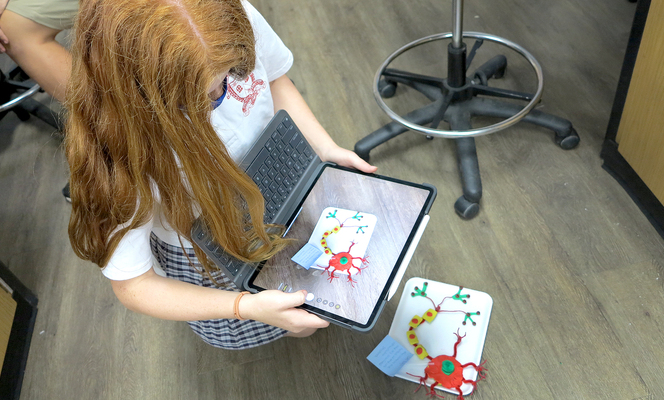
By BETH DONZE
Clarion Herald
Earlier this month, students wielding iPads photographed their clay models of the parts of a nerve cell, color-coded masterpieces showing the webbed dendrites and nucleus of the main cell body, and the attached axon – the cord-like part of the cell that transports nerve signals and contains specialized “Schwann cells” that produce the cell’s insulating myelin sheath.Their latest challenge: manipulating those cell models to create stop-motion videos simulating the movement of a nerve signal through the cell.
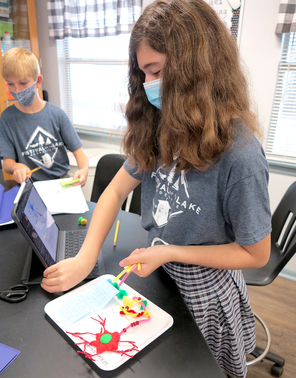 In coming weeks, the students will conduct similar hands-on studies of the parts of the brain, with the culminating challenge asking them to diagnose a neurological problem based on a list of symptoms provided by their teacher. They will hypothesize which lobe of the brain contains the “tumor” and then remove it – from a real sheep’s brain.
In coming weeks, the students will conduct similar hands-on studies of the parts of the brain, with the culminating challenge asking them to diagnose a neurological problem based on a list of symptoms provided by their teacher. They will hypothesize which lobe of the brain contains the “tumor” and then remove it – from a real sheep’s brain.If all of this sounds like a level of critical thinking expected of a high school or college scientist, you would be correct. But all of these STEM-related pursuits are being tackled by seventh graders at Our Lady of the Lake School in Mandeville, and similarly advanced investigations are being undertaken by all OLL students in prekindergarten on up through the Project Lead the Way (PLTW) STEM curriculum.
“By the end of this module, they will never forget the parts of a neuron,” smiled Kristi Spell, OLL’s middle school science teacher, also sharing what her sixth graders have been up to: learning about the neurological underpinnings of cerebral palsy (CP) and then designing and making their own orthotic boots to help children with CP position their feet while walking. Soon they will be designing and producing a toy for these children on the 3D printer.
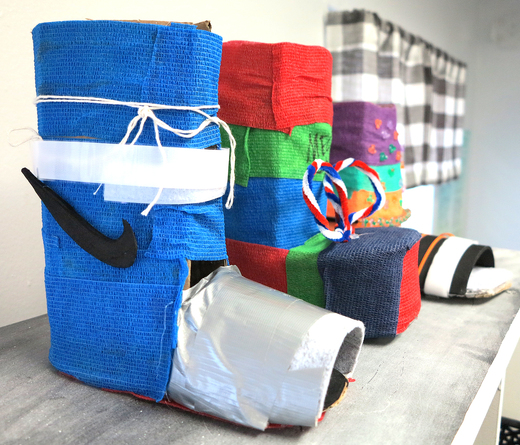
“They’re learning how to design like an engineer,” Spell said. “PLTW has completely transformed the way I teach and the way the kids learn.”In recognition of how ingrained the STEM program is at Our Lady of the Lake, the school received “STEM certification” last spring from the Cognia accreditation body. OLL is the only elementary school in Louisiana to achieve the distinction and also garnered Cognia’s highest rating in each of the four areas of assessment. Rather than just looking at how technologically equipped a given school is, Cognia wants to know how students are using that technology across disciplines to solve real-world problems and fuel career aspirations in the STEM fields of science, technology, engineering and math, noted Frank Smith, OLL’s principal.
“We didn’t want our students to begin (advanced STEM instruction) when they got to high school – because by the time you get to high school, there is that perception that only certain people are ‘good at math,’ or ‘good at science,’” Smith said. “We wanted to make sure they got it during their formative years, that there were no external forces determining which direction they should go,” he added. “Everyone can conduct scientific investigation and (hone their) critical thinking skills.”
Recent STEM modules attest to that striving. Third graders are currently engrossed in aerodynamics, building and testing gliders and tweaking their designs based on their flight results; first graders are conducting temperature-related experiments comparing the effects of cold water versus hot water on candy coatings; and fifth graders are coding their own computer models to simulate the spread of communicable diseases using Scratch software.
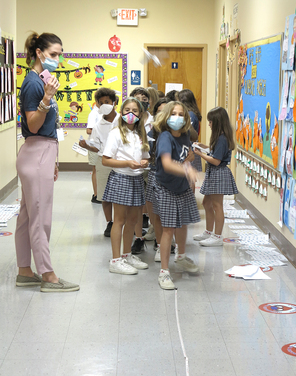
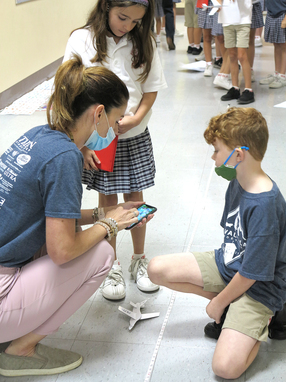 “Our fifth graders can give you detailed information on ‘viral versus bacterial,’” said Vita Dickens, OLL’s assistant principal. “It’s so relevant and so interesting to hear that they understand why we’re doing what we’re doing right now as a community (during a pandemic).”
“Our fifth graders can give you detailed information on ‘viral versus bacterial,’” said Vita Dickens, OLL’s assistant principal. “It’s so relevant and so interesting to hear that they understand why we’re doing what we’re doing right now as a community (during a pandemic).”Students focus on a different PLTW module every quarter, carrying out most of their STEM work in daily science class, OLL’s multi-media center and makerspace.
Their teachers also connect their STEM studies to subjects such as religion, art, English and social studies. Every teacher in grades pre-K through third grade, as well as science teachers in the older grades, are PLTW certified and take rigorous courses over the summer to learn new modules.
“They’re so invested. They love how much the kids love it,” Dickens said. “I cannot remember a student saying anything negative (about STEM). Suddenly, science is the coolest thing. The students drive it, and I think that motivates the teachers to constantly do more.”
The program is constantly showing how technology is a tool – not just gadgets to play with. Students learn they can create with technology, and not just consume it.
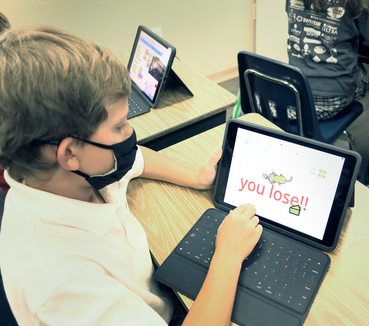 For example, fourth graders in the science class of teacher Ally Spell are in the midst of designing and coding their own video games on iPads, complete with music and graphics. After that, they will share their game with their peers to test its appeal.
For example, fourth graders in the science class of teacher Ally Spell are in the midst of designing and coding their own video games on iPads, complete with music and graphics. After that, they will share their game with their peers to test its appeal.“They will show me their games and they just blow me away,” Spell said. ”I teach them the basics, and then they do the rest by themselves. A video game seems so simple, but there’s so much work that goes into it!”
Fourth grader Patch Callahan was busy “debugging” his own game, entitled “Cat and Mouse” – a timed race in which the mouse tries to find the cheese before the cat catches him.
“I like STEM because it’s complicated,” Patch explained.
One past project had second graders designing simple machines to save the life of a trapped animal at the zoo. Their work seeped into religion through a class discussion on care for God’s creation.
“It’s reinforcing this idea that you can solve the problem if you go through the engineering process,” said Alice Snee, OLL’s middle school curriculum coordinator, noting that she overhears 4-year-olds discussing the parts of the eye and other students saying how they now want to be an “Imagineer” who designs roller coasters.
“PLTW invites them behind the scenes, so they can be the creators and makers,” Snee said.
Smith said students who had never gotten excited about science are happily diving into STEM.
“That was our mindset – math doesn’t have to be ‘boring’; science doesn’t have to be ‘boring,’” he said. “They are learning to think outside the box, so they’ll be creating jobs that we don’t even know about yet in fields like robotics. These kids won’t have any fears about considering those kinds of jobs!”
[email protected]




